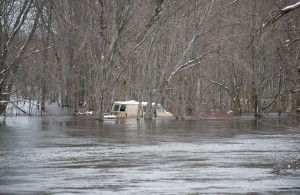Make The Next Flood Season Less Deadly

Deaths from flash and river floods accounted for the some of the highest number of fatalities due to natural hazards in the United States in 2013, according to the National Weather Service.
Floods claimed 82 lives, almost triple the 29 deaths in 2012. Nearly half of those fatalities, occurred in a vehicle, often as drivers and passengers tried to cross a flooded road.
Flash floods are secondary disasters, usually occurring within six hours of events such as heavy rain, rapid snow melt or levee failure. Most fatalities occur in areas near a stream or river. Highly populated or developed areas can also be at high risk from flash flood because there is less ground to absorb water runoff.
The White House Innovation for Disaster Response and Recovery Initiative recently launched a new website, www.disasters.data.gov, which aggregates data on U.S. disaster damages and response tools. Part of the initiative’s effort to foster discussion among those working in the disaster response field is a regular “innovator challenge” question that asks for suggestions on a particular disaster need. The first innovator challenge question, posted last month, asks how to use “real-time sensors, open data, social media, and other tools to help reduce the number of fatalities from flooding.”
As we wait for the arrival of spring rains across much of the nation, here are our suggestions to this question:
- Know your proximity to a stream or waterway and be aware that flash floods can begin miles upstream from your location.
- If you are outdoors near a stream, stay alert for rapidly changing conditions and leave the area if you are boating, fishingor hiking and nearby water begins to swell.
- Two feet of water on a bridge or roadway is enough to float a vehicle. Because almost half of flood fatalities occur in vehicles, avoid driving through water, even if it looks shallow.
- Educators are strategically placed to share information with children and families about the risks of flash flooding, how to watch for areas of flooding and how quickly roads can wash out. Children are often better listeners than adults.
Communities and disaster response agencies can also do their part to help. Among them:
- Revamp road closure procedures. With such a high percentage of fatalities occurring in vehicles, it makes sense for regional responders to evaluate areas at risk of floods more closely and consider earlier closures. Coordination is needed between local officials and law enforcement and first responders to develop maps on flash flood pathways and identify ahead of time who is responsible for closures and who will post updates to websites and social media.
- Develop park closure plans and related emergency procedures. The chances of being caught in a flash flood are significantly higher if you are near a stream or water source. Parks are easy to close and evacuate, eliminating the risks. Parks also should be equipped with adequate storm sirens that can be used in the event of emergencies.
- Educate people living in close proximity to steams or flood areas. Identify neighborhoods and businesses near to areas prone to flash floods and conduct regular awareness and action campaigns. Activities might include public service announcements on radio and television in anticipation of a large rain or melt event, as well as using social media platforms to provide timely information.
Do you have other ideas about how to reduce the risk of death from floods? Email us at anna.hurt@disasterphilanthropy.org and nancy.beers@disasterphilanthropy.org.
More like this

The Time to Prepare is Now

